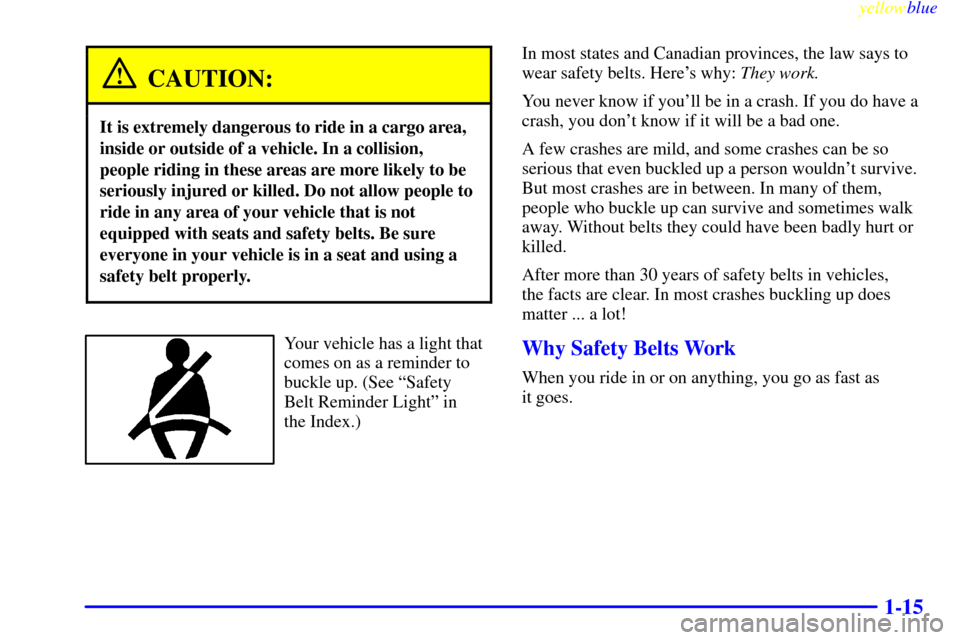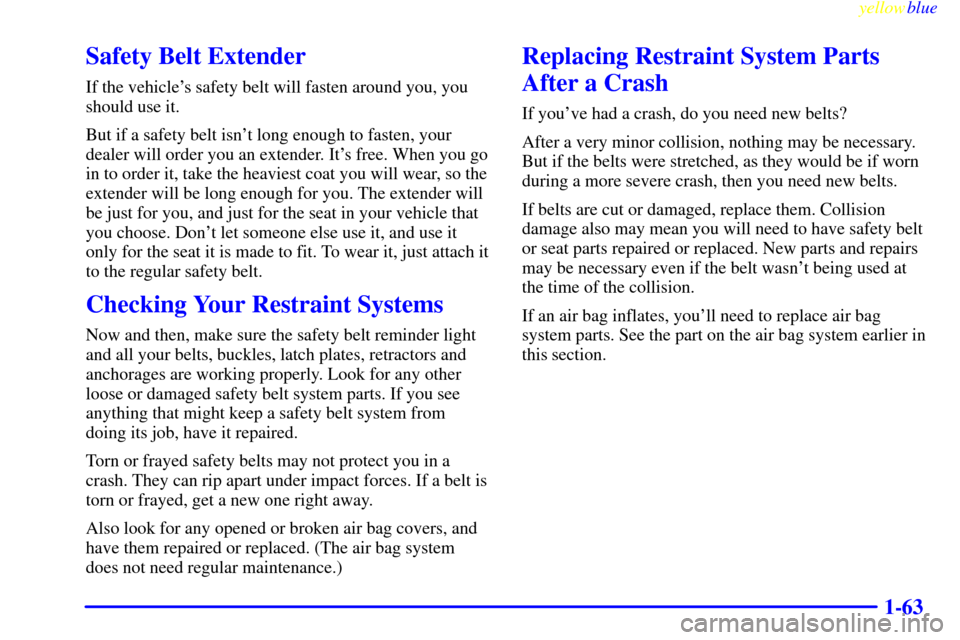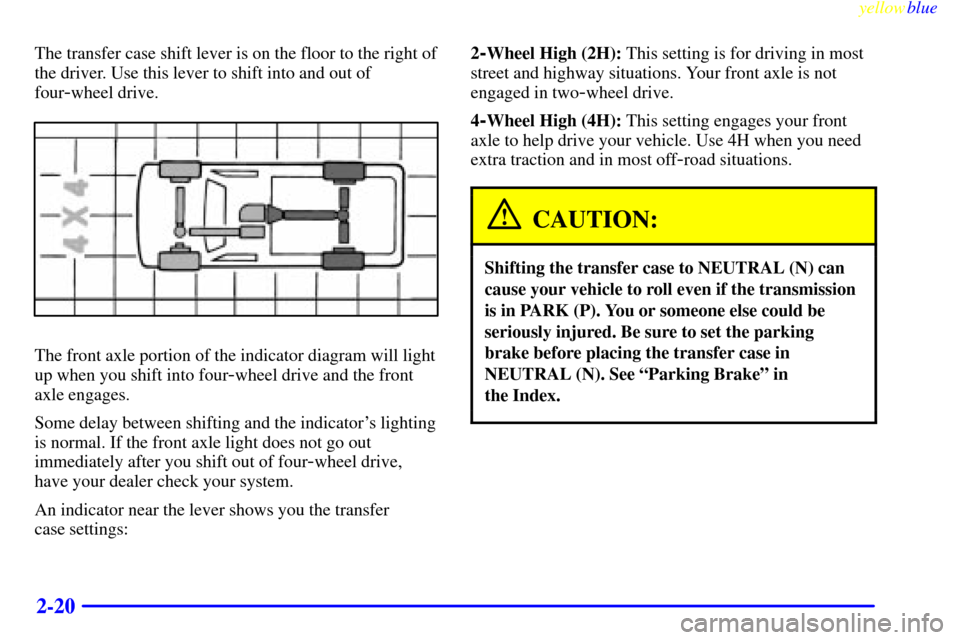Page 5 of 424
yellowblue
v
For example,
these symbols
are used on an
original battery:
CAUTION
POSSIBLE
INJURY
PROTECT
EYES BY
SHIELDING
CAUSTIC
BATTERY
ACID COULD
CAUSE
BURNS
AVOID
SPARKS OR
FLAMES
SPARK OR
FLAME
COULD
EXPLODE
BATTERY
These symbols
are important
for you and
your passengers
whenever your
vehicle is
driven:
DOOR LOCK
UNLOCK
FASTEN
SEAT
BELTS
POWER
WINDOW
AIR BAG
These symbols
have to do with
your lamps:
MASTER
LIGHTING
SWITCH
TURN
SIGNALS
PARKING
LAMPS
HAZARD
WARNING
FLASHER
DAYTIME
RUNNING
LAMPS
FOG LAMPS
These symbols
are on some of
your controls:
WINDSHIELD
WIPER
WINDSHIELD
WASHER
WINDSHIELD
DEFROSTER
REAR
WINDOW
DEFOGGER
VENTILATING
FAN
These symbols
are used on
warning and
indicator lights:
ENGINE
COOLANT
TEMP
BATTERY
CHARGING
SYSTEM
BRAKE
COOLANT
ENGINE OIL
PRESSURE
ANTI-LOCK
BRAKES
Here are some
other symbols
you may see:
FUSE
LIGHTER
HORN
SPEAKER
FUEL
Vehicle Symbols
These are some of the symbols you may find on your vehicle.
Page 21 of 424

yellowblue
1-15
CAUTION:
It is extremely dangerous to ride in a cargo area,
inside or outside of a vehicle. In a collision,
people riding in these areas are more likely to be
seriously injured or killed. Do not allow people to
ride in any area of your vehicle that is not
equipped with seats and safety belts. Be sure
everyone in your vehicle is in a seat and using a
safety belt properly.
Your vehicle has a light that
comes on as a reminder to
buckle up. (See ªSafety
Belt Reminder Lightº in
the Index.)In most states and Canadian provinces, the law says to
wear safety belts. Here's why: They work.
You never know if you'll be in a crash. If you do have a
crash, you don't know if it will be a bad one.
A few crashes are mild, and some crashes can be so
serious that even buckled up a person wouldn't survive.
But most crashes are in between. In many of them,
people who buckle up can survive and sometimes walk
away. Without belts they could have been badly hurt or
killed.
After more than 30 years of safety belts in vehicles,
the facts are clear. In most crashes buckling up does
matter ... a lot!Why Safety Belts Work
When you ride in or on anything, you go as fast as
it goes.
Page 37 of 424
yellowblue
1-31
There is an air bag
readiness light on the
instrument panel, which
shows AIR BAG.
The system checks the air bag electrical system for
malfunctions. The light tells you if there is an electrical
problem. See ªAir Bag Readiness Lightº in the Index
for more information.How the Air Bag System Works
Where are the air bags?
The driver's air bag is in the middle of the
steering wheel.
Page 69 of 424

yellowblue
1-63
Safety Belt Extender
If the vehicle's safety belt will fasten around you, you
should use it.
But if a safety belt isn't long enough to fasten, your
dealer will order you an extender. It's free. When you go
in to order it, take the heaviest coat you will wear, so the
extender will be long enough for you. The extender will
be just for you, and just for the seat in your vehicle that
you choose. Don't let someone else use it, and use it
only for the seat it is made to fit. To wear it, just attach it
to the regular safety belt.
Checking Your Restraint Systems
Now and then, make sure the safety belt reminder light
and all your belts, buckles, latch plates, retractors and
anchorages are working properly. Look for any other
loose or damaged safety belt system parts. If you see
anything that might keep a safety belt system from
doing its job, have it repaired.
Torn or frayed safety belts may not protect you in a
crash. They can rip apart under impact forces. If a belt is
torn or frayed, get a new one right away.
Also look for any opened or broken air bag covers, and
have them repaired or replaced. (The air bag system
does not need regular maintenance.)
Replacing Restraint System Parts
After a Crash
If you've had a crash, do you need new belts?
After a very minor collision, nothing may be necessary.
But if the belts were stretched, as they would be if worn
during a more severe crash, then you need new belts.
If belts are cut or damaged, replace them. Collision
damage also may mean you will need to have safety belt
or seat parts repaired or replaced. New parts and repairs
may be necessary even if the belt wasn't being used at
the time of the collision.
If an air bag inflates, you'll need to replace air bag
system parts. See the part on the air bag system earlier in
this section.
Page 71 of 424

2-
yellowblue
2-1
Section 2 Features and Controls
Here you can learn about the many standard and optional features on your vehicle, and information on starting,
shifting and braking. Also explained are the instrument panel and the warning systems that tell you if everything is
working properly
-- and what to do if you have a problem.
2
-2 Keys
2
-3 Door Locks
2
-6 Keyless Entry System (If Equipped)
2
-8 Your Doors and How They Work
2
-10 Theft
2
-11 Passlock�
2-12 New Vehicle ªBreak-Inº
2
-12 Ignition Positions
2
-13 Starting Your Gasoline Engine
2
-15 Engine Coolant Heater (If Equipped)
2
-16 Automatic Transmission Operation
2
-19 Four-Wheel Drive (If Equipped)
2
-25 Parking Brake
2
-26 Shifting Into Park (P)
2
-28 Shifting Out of Park (P)
2
-29 Parking Over Things That Burn2
-29 Engine Exhaust
2
-30 Running Your Engine While You're Parked
2
-31 Locking Rear Axle (If Equipped)
2
-31 Windows
2
-33 Tilt Wheel (If Equipped)
2
-34 Multifunction Lever
2
-40 Exterior Lamps
2
-41 Interior Lamps
2
-43 Mirrors
2
-53 Storage Compartments
2
-62 Ashtrays and Cigarette Lighter
2
-64 Sun Visors
2
-64 Universal Transmitter (If Equipped)
2
-68 Instrument Panel
2
-70 Instrument Panel Cluster
2
-72 Warning Lights, Gages and Indicators
Page 81 of 424

yellowblue
2-11 Parking at Night
Park in a lighted spot, close all windows and lock your
vehicle. Remember to keep your valuables out of sight.
Put them in a storage area, or take them with you.
Parking Lots
If you park in a lot where someone will be watching
your vehicle, it's best to lock it up and take your keys.
But what if you have to leave your ignition key? What if
you have to leave something valuable in your vehicle?
�Put your valuables in a storage area, like your
glove box.
�Lock all the doors except the driver's.
Passlock�
Your vehicle is equipped with the Passlock
theft
-deterrent system.
Passlock is a passive theft
-deterrent system. Passlock
enables fuel if the ignition lock cylinder is turned with a
valid key. If a correct key is not used or the ignition lock
cylinder is tampered with, fuel is disabled.During normal operation, the SECURITY light will go
off approximately five seconds after the key is turned to
the RUN ignition position.
If the engine stalls and the SECURITY light flashes,
wait until the light stops flashing before trying to restart
the engine. Remember to release the key from START
as soon as the engine starts.
If the engine is running and the SECURITY light comes
on, you will be able to restart the engine if you turn the
engine off. However, your Passlock system is not
working properly and must be serviced by your dealer.
Your vehicle is not protected by Passlock at this time.
You may also want to check the fuse (see ªFuses and
Circuit Breakersº in the Index). See your dealer
for service.
In an emergency, call the Roadside Assistance Center.
Page 90 of 424

yellowblue
2-20
The transfer case shift lever is on the floor to the right of
the driver. Use this lever to shift into and out of
four
-wheel drive.
The front axle portion of the indicator diagram will light
up when you shift into four
-wheel drive and the front
axle engages.
Some delay between shifting and the indicator's lighting
is normal. If the front axle light does not go out
immediately after you shift out of four
-wheel drive,
have your dealer check your system.
An indicator near the lever shows you the transfer
case settings:2
-Wheel High (2H): This setting is for driving in most
street and highway situations. Your front axle is not
engaged in two
-wheel drive.
4
-Wheel High (4H): This setting engages your front
axle to help drive your vehicle. Use 4H when you need
extra traction and in most off
-road situations.
CAUTION:
Shifting the transfer case to NEUTRAL (N) can
cause your vehicle to roll even if the transmission
is in PARK (P). You or someone else could be
seriously injured. Be sure to set the parking
brake before placing the transfer case in
NEUTRAL (N). See ªParking Brakeº in
the Index.
Page 91 of 424

yellowblue
2-21
NEUTRAL (N): Shift to this setting only when
your vehicle needs to be towed or when using a
power take
-off.
4
-Wheel Low (4L): This setting also engages your
front axle to give you extra power and also gives you a
higher driveline ratio. It should be used only for
off
-road driving.
You can shift from 2
-Wheel High (2H) to 4-Wheel
High (4H) or from 4
-Wheel High (4H) to 2-Wheel
High (2H) while the vehicle is moving. Your front axle
will engage faster if you take your foot off the
accelerator for a few seconds after you shift. In
extremely cold weather, it may be necessary to stop or
slow the vehicle to shift into 4
-Wheel High (4H).To shift into or out of 4
-Wheel Low (4L) or
NEUTRAL (N):
1. Slow the vehicle to a roll, about 1 to 3 mph
(2 to 5 km/h) and shift the transmission into
NEUTRAL (N).
2. Shift the transfer case shift lever in one
continuous motion.
Don't pause in NEUTRAL (N) as you shift the transfer
case into 4
-Wheel Low (4L), or your gears could clash.
Remember that driving in 4
-Wheel High (4H) or
4
-Wheel Low (4L) may reduce fuel economy. Also,
driving in four
-wheel drive on dry pavement could
cause your tires to wear faster and make your transfer
case harder to shift and run noisier.
When your headlamps or parking lamps are on, rotate the
thumbwheel next to the headlamp switch up to brighten or
down to dim your transfer case indicator light.